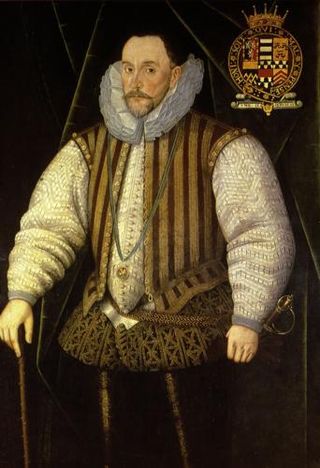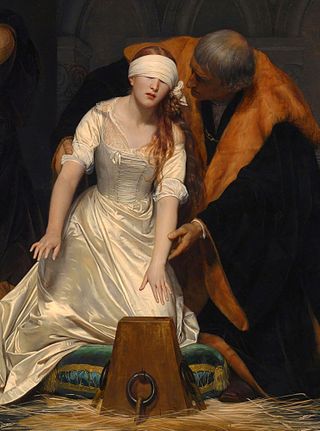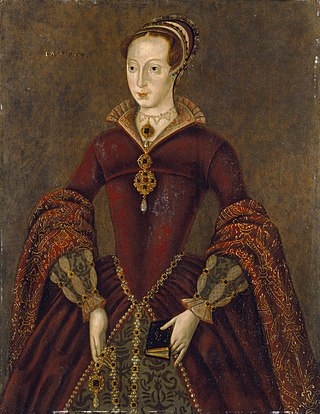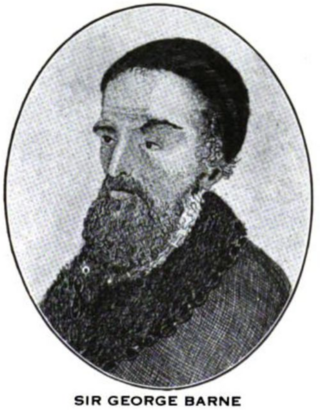Related Research Articles

Mary I, also known as Mary Tudor, and as "Bloody Mary" by her Protestant opponents, was Queen of England and Ireland from July 1553 and Queen of Spain and the Habsburg dominions as the wife of King Philip II from January 1556 until her death in 1558. She is best known for her vigorous attempt to reverse the English Reformation, which had begun during the reign of her father, King Henry VIII. Her attempt to restore to the Church the property confiscated in the previous two reigns was largely thwarted by Parliament, but during her five-year reign, Mary had over 280 religious dissenters burned at the stake in the Marian persecutions.

Katherine Seymour, Countess of Hertford was a younger sister of Lady Jane Grey.

Henry Herbert, 2nd Earl of Pembroke, KG, KB was an English peer and politician. He was the nephew of Catherine Parr and brother-in-law of Lady Jane Grey through his first wife.
John Sutton, 3rd Baron Dudley, commonly known as Lord Quondam, was an English nobleman.

Henry Grey, Duke of Suffolk, 3rd Marquess of Dorset, was an English courtier and nobleman of the Tudor period. He was the father of Lady Jane Grey, known as "the Nine Days' Queen".

John Brydges, 1st Baron Chandos was an English courtier, Member of Parliament and later peer. His last name is also sometimes spelt Brugge or Bruges. He was a prominent figure at the English court during the reigns of Kings Henry VIII and Edward VI and of Queen Mary I.

Sir Thomas White was an English cloth merchant, Lord Mayor of London in 1553, and a civic benefactor and founder of St John's College, Oxford and Merchant Taylors' School.

Lady Jane Grey, also known as Lady Jane Dudley after her marriage and as the "Nine Days' Queen", was an English noblewoman who claimed the throne of England and Ireland from 10 to 19 July 1553.

Charles Stourton, 8th Baron Stourton was an English peer who was executed for murder.
Events from the 1550s in England. This decade marks the beginning of the Elizabethan era.
Jane Dudley, Duchess of Northumberland was an English courtier. She was the wife of John Dudley, 1st Duke of Northumberland, and mother of Guildford Dudley and Robert Dudley, 1st Earl of Leicester. Having grown up with her future husband, who was her father's ward, she married at about age 16. They had 13 children.

Sir Andrew Dudley, KG was an English soldier, courtier, and diplomat. A younger brother of John Dudley, 1st Duke of Northumberland, he served in Henry VIII's navy and obtained court offices under Edward VI. In 1547–1548 he acted as admiral of the fleet and participated in the War of the Rough Wooing in Scotland, where he commanded the English garrison of Broughty Castle. He was appointed captain of the fortress of Guînes in the Pale of Calais in late 1551. There he got involved in a dispute with the Lord Deputy of Calais, which ended only when both men were replaced in October 1552.
Henry Dudley was an English soldier and an elder brother of Queen Elizabeth I's favourite, Robert Dudley, Earl of Leicester. Their father was John Dudley, Duke of Northumberland, who led the English government from 1550 to 1553 under Edward VI and unsuccessfully tried to establish Lady Jane Grey on the English throne after the King's death in July 1553. For his participation in this venture Henry Dudley was imprisoned in the Tower of London and condemned to death, but pardoned.
Mary Finch or Fynche (1508-1557) was an English courtier of Mary I of England.

An inventory of the jewels of Mary I of England, known as Princess Mary or the Lady Mary in the years 1542 to 1546, was kept by her lady in waiting Mary Finch. The manuscript is now held by the British Library. It was published by Frederic Madden in 1831. Some pieces are listed twice. Two surviving drawings feature a ribbon with the inscription, "MI LADI PRINSIS". The British Library also has an inventory of the jewels she inherited on coming to the throne in 1553.

Sir George Barne was an English businessman in the City of London who was active in developing new trading links with Russia, West Africa and North America, far outside what had been traditional English trading patterns. Created a knight in 1553, he served as Sheriff of London and Lord Mayor of London. He was the father of Sir George Barne and grandfather of Sir William Barne. Nicholas Culverwell was probably a nephew.

Mary I of England (1516–1558) and Philip of Spain married at Winchester Cathedral on Wednesday 25 July 1554.

The coronation of Mary I as Queen of England and Ireland took place at Westminster Abbey, London, on Sunday 1 October 1553. This was the first coronation of a queen regnant in England, a female ruler in her own right. The ceremony was therefore transformed. Ritual and costume were interlinked. Contemporary records insist the proceedings were performed "according to the precedents", but mostly these were provisions made previously for queens consort.
Simon Henton or Heinton was a Dominican provincial in England and a biblical commentator. Most of his works are lost.
Frideswide Strelley, was an English courtier. She served as chamberer to Queen Mary I from 1536 onward.
References
- ↑ 'STOURTON, Arthur (by 1525-58)', The History of Parliament: the House of Commons 1509-1558, ed. S.T. Bindoff, 1982
- ↑ The history of the noble house of Stourton, 1, p. 315
- ↑ "STOURTON, Arthur (by 1525-58), of Westminster", The History of Parliament: the House of Commons 1509-1558, ed. S.T. Bindoff, 1982
- ↑ Royall Tyler, Calendar State Papers Spain, 11 (London, 1916), p. 185 fn. 4.
- ↑ Eamon Duffy, Saints, Sacrilege and Sedition: Religion and Conflict in the Tudor Reformations (Bloomsbury, 2012), pp. 126, 128: Charles Botolph Joseph, Lord Mowbray, Segrave and Stourton, The history of the noble house of Stourton, 1 (London, 1899), p. 314
- ↑ John Gough Nichols, Diary of Henry Machyn (London: Camden Society, 1848), pp. 165–166, 363
- ↑ John Strype, Ecclesiastical memorials, 3 (London, 1721), p. 444
- ↑ Henry Octavius Coxe, Catalogues codicum MSS qui in collegiis aulisque Oxoniensibus, 1 (Oxford, 1852), p. 118, printed in Nicholas Harris Nicolas, The Literary Remains of Lady Jane Grey with a Memoir of Her Life (London, 1831), p. cxxix
- ↑ H. B. Walters, "Inventories of Worcestershire Church Goods", Transactions of the Worcestershire Archaeological Society, 17 (1940), p. 12: J. Robert Daniel-Tyssen, "Inventories of the churches in Surrey", Surrey Archaeological Collections, 4 (1869), pp. 139, 141
- ↑ HMC 7th Report: Molyneux (London, 1879), p. 608.
- ↑ Rev. Canon Scott Robertson, "Queen Mary's responsibility for parish church goods seized by King Edward's commissioners", Archaeologia Cantiana, 14 (1882), pp. 314–315, 317, 322
- ↑ William Douglas Hamilton, A Chronicle of England During the Reigns of the Tudors by Charles Wriothesley, 2 (London: Camden Society, 1877), pp. 83–84.
- ↑ Eamon Duffy, Saints, Sacrilege and Sedition: Religion and Conflict in the Tudor Reformations (Bloomsbury, 2012), pp. 127–128.
- ↑ Susan Brigden, London and the Reformation (Oxford, 1989): Transcript of the Registers of the United Parishes of S. Mary Woolnoth (London, 1886), p. xx.
- ↑ Rev. Canon Scott Robertson, "Queen Mary's responsibility for parish church goods seized by King Edward's commissioners", Archaeologia Cantiana, 14 (1882), pp. 321–322.
- ↑ James Peller Malcolm, Londinium redivivum, 4 (London, 1807), p. 424.
- ↑ Adam Smyth, Autobiography in Early Modern England (Cambridge, 2010), p. 202.
- ↑ Ian Mortimer, "Tudor Chronicler or Sixteenth-Century Diarist? Henry Machyn and the Nature of His Manuscript", The Sixteenth Century Journal, 33:4 (Winter 2002), pp. 981-998.
- ↑ Andrew Gordon, Writing Early Modern London: Memory, Text and Community (Palgrave Macmillan, 2013), p. 44: John Gough Nichols, Diary of Henry Machyn (London: Camden Society, 1848), p. 166
- ↑ Elizabeth Goldring et al., John Nichols's The Progresses and Public Processions of Queen Elizabeth, 1 (Oxford, 2014), pp. 54–56.
- ↑ Henry Octavius Coxe, Catalogues codicum MSS qui in collegiis aulisque Oxoniensibus, 1 (Oxford, 1852), p. 117 nos. 3, 4
- ↑ Nicholas Harris Nicolas, The Literary Remains of Lady Jane Grey with a Memoir of Her Life (London, 1825), pp. cxxix*–cxlii.
- ↑ John Nichols, History and Antiquities of the County of Leicester, 3: (London, 1804), p. 670: George Howard, Lady Jane Grey And Her Times (London 1822), p. 257
- ↑ Eric Ives, Lady Jane Grey: A Tudor Mystery (Blackwell, 2009), p. 188: Agnes Strickland, Lives of the Tudor Princesses Including Lady Jane Gray and Her Sisters (London, 1868), pp. 153–155.
- ↑ Henry Octavius Coxe, Catalogues codicum MSS qui in collegiis aulisque Oxoniensibus, 1 (Oxford, 1852), p. 117
- ↑ Henry Octavius Coxe, Catalogues codicum MSS qui in collegiis aulisque Oxoniensibus, 1 (Oxford, 1852), p. 118.
- ↑ HMC Calendar of the manuscripts of the Most Honourable the Marquess of Salisbury, 1 (London, 1883), pp. 127–132
- ↑ HMC Calendar of the manuscripts of the Most Honourable the Marquess of Salisbury, 1 (London, 1883), p. 130.
- ↑ Albert Feuillerat, Documents Relating to the Revels at Court in the Time of King Edward VI and Queen Mary (Louvain, 1914), pp. 245, 304 fn. 27
- ↑ The history of the noble house of Stourton, 1, p. 314
- ↑ The history of the noble house of Stourton, 2, p. 1071
- ↑ Albert Feuillerat, Documents Relating to the Revels at Court in the Time of King Edward VI and Queen Mary, p. 304 fn. 27: Index to the Additional Manuscripts: With Those of the Egerton Collection, p. 59 (British Library Add. 5751).
- ↑ Craven Ord, "Copies of Five Curious Writs of Privy Seal", Archaeologia, vol. 16 (London, 1812), pp. 92–93
- ↑ John Paul Rylands, The Visitation of the County of Dorset: Taken in the Year 1623 (London, 1885), p. 86.